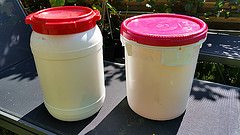AcroporAddict
There is no substitute.
I do not think you will find it here at the pricing suggested, even at online greenhouse supply places. Sulfur is used in greenhouses in sulfur burners that treat rose diseases, like mildew. Do a google under "sulfur prills", and you will see multiple ads on eBay and amazon for 4 pounds of sulfur prills for like $25-$30. A gallon of LSM has about 9.5 pounds of media in it, and I can buy it all day long locally for $29 a gallon. BigAlsOnline has it for $24.95 a gallon. Seems decent online pricing for LSM is $21-$25 a gallon, but it may have extra shipping costs because of the weight.
I have not been able to find it anywhere in the US at the price point Belgian suggests. Not saying it might not be there somewhere, but I always look for bargains online, and did not see it anywhere at $5 a gallon, at least Domestically.
I have not been able to find it anywhere in the US at the price point Belgian suggests. Not saying it might not be there somewhere, but I always look for bargains online, and did not see it anywhere at $5 a gallon, at least Domestically.
Last edited:

